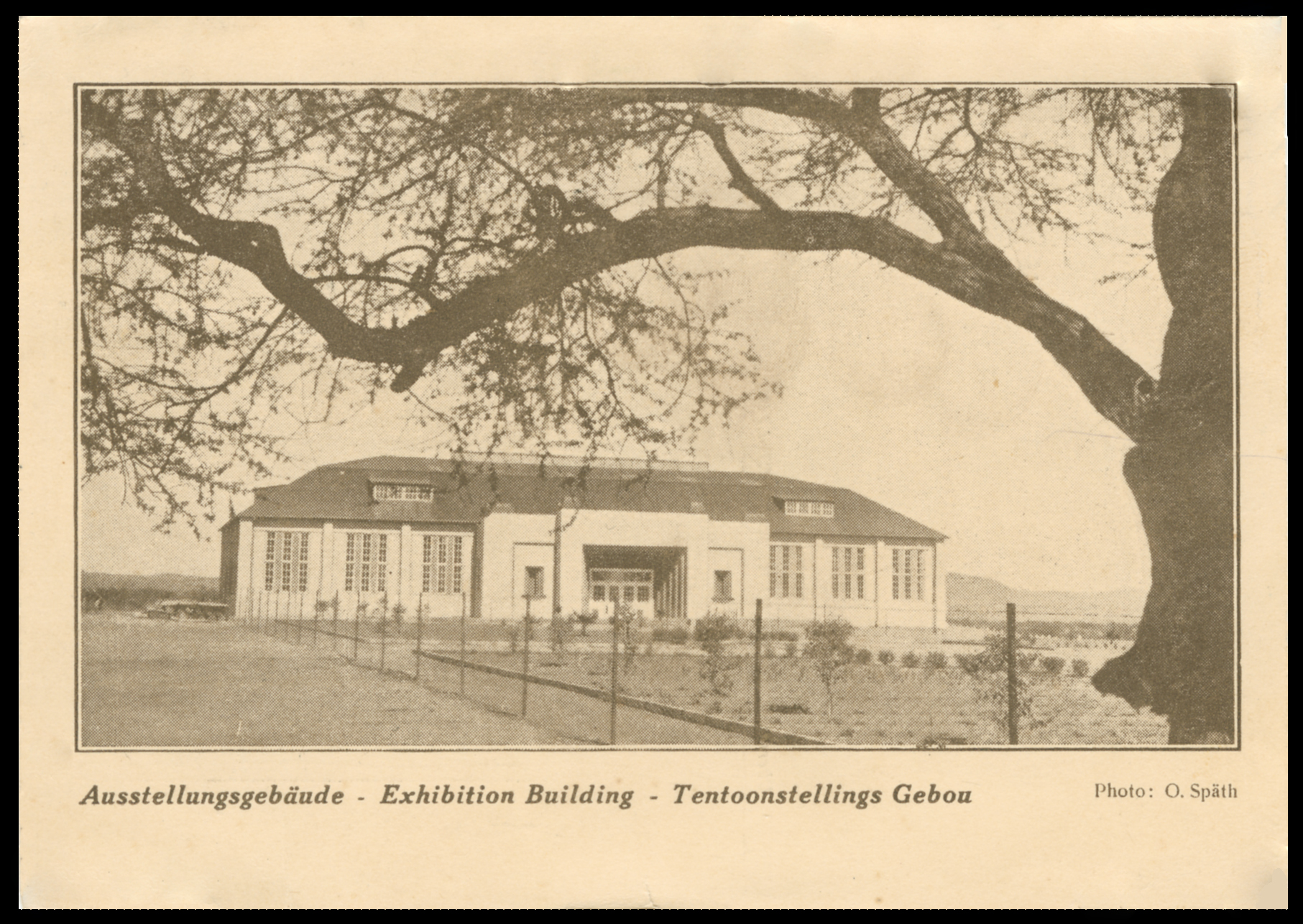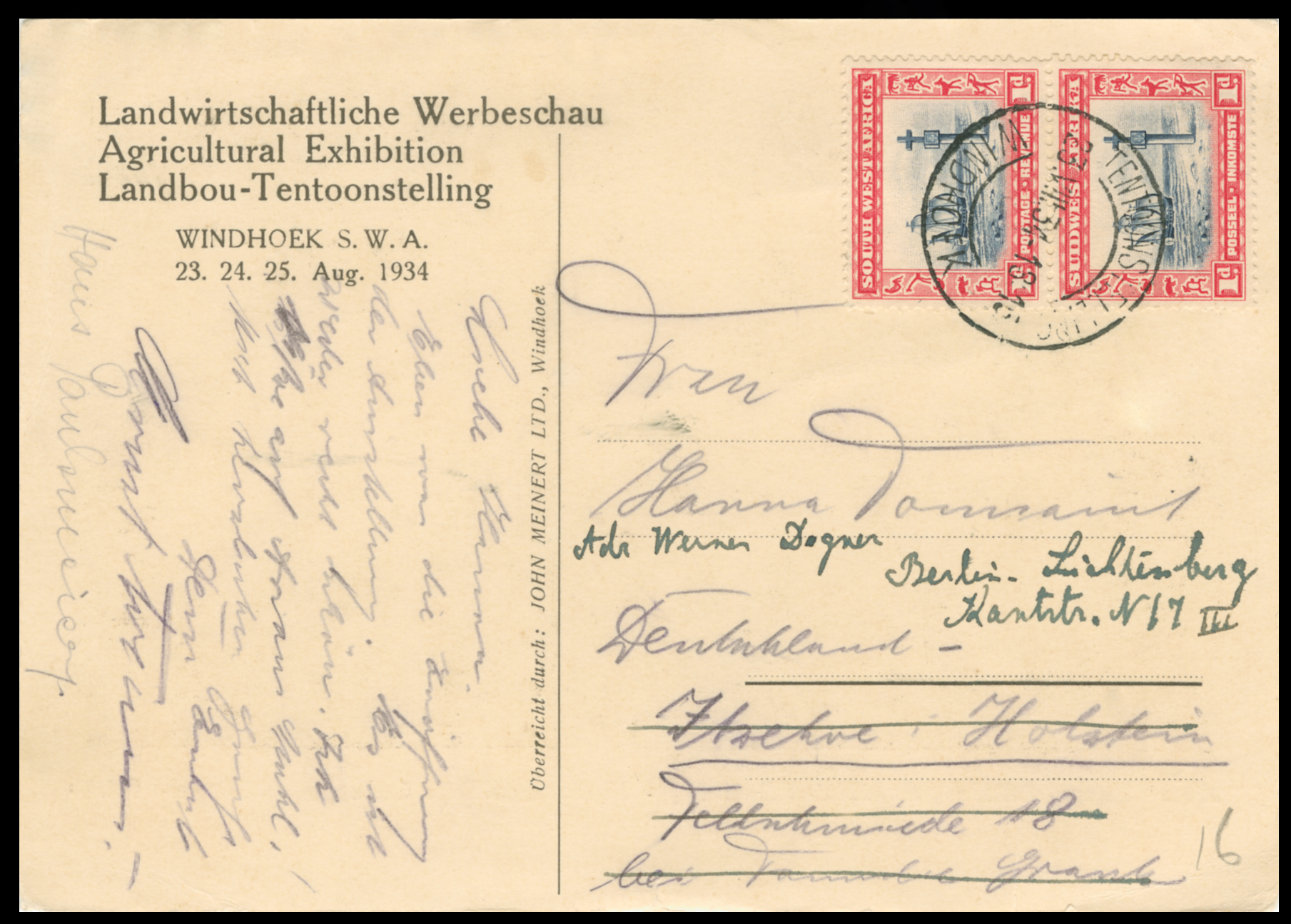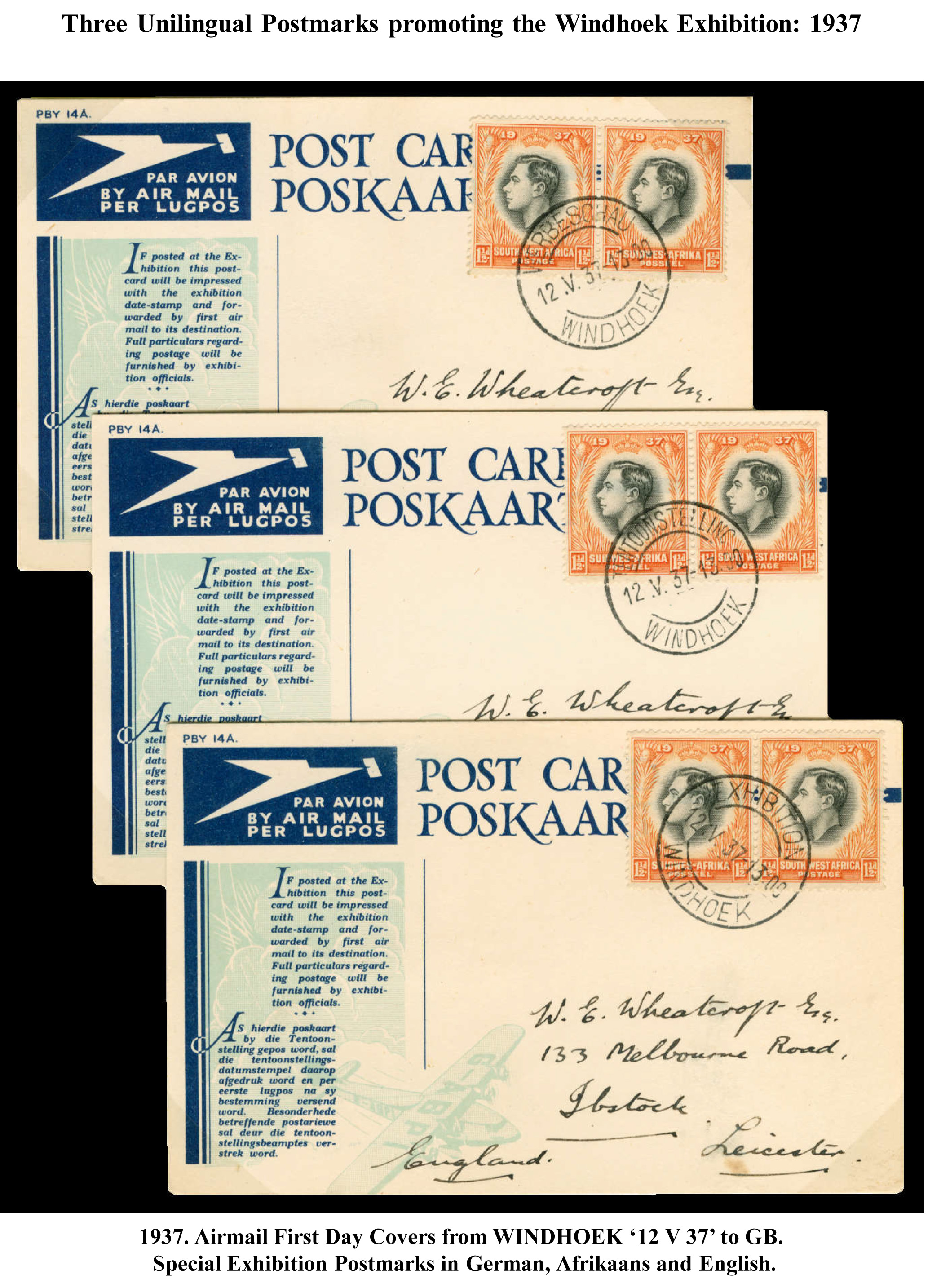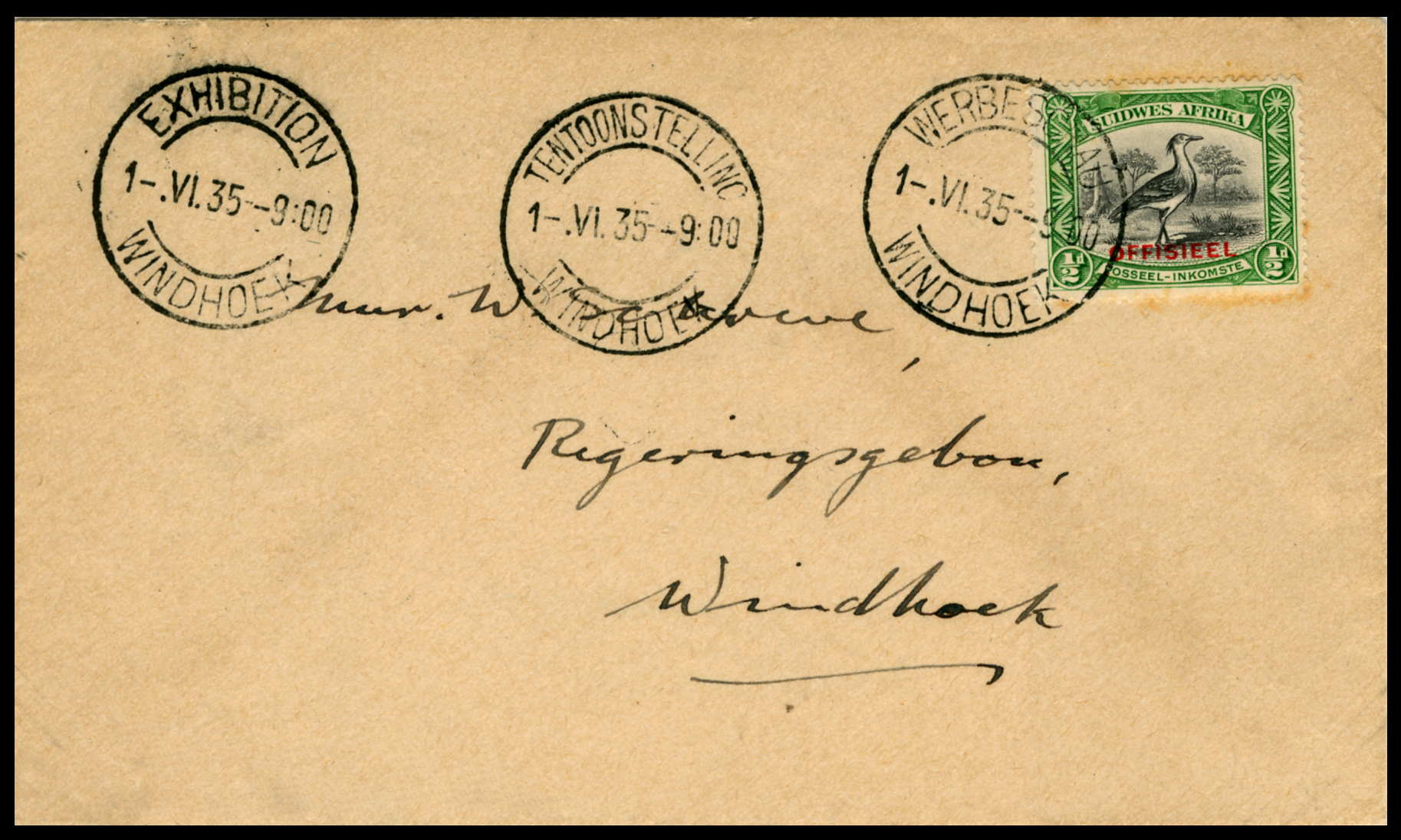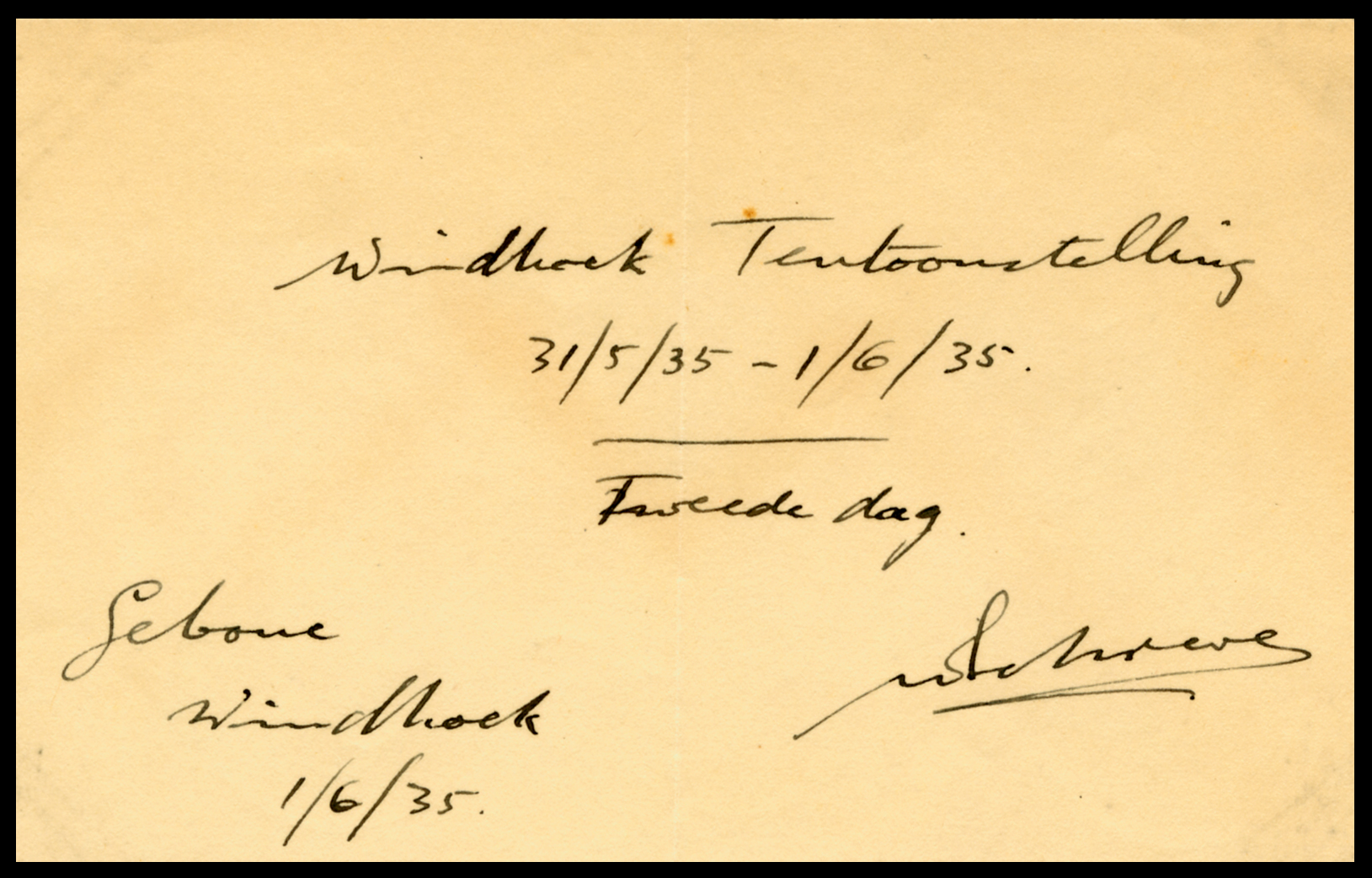SWA: The 1934 - 1937 Windhoek Exhibition Trilingual Cancellers
Quote from Steve on February 8, 2023, 5:08 pmAs a member of the South African Collectors' Society, I receive their magazine, 'The Springbok', (published quarterly, UK). It is not available to non-members. Two options exist, a printed copy and a more affordable emailed one.
In SOUTH WEST CORNER, (The Springbok 358, April 2022, Page 71), Tony Howgrave-Graham requested help with the identification of the exhibition that used the trilingual "1934-7 WINDHOEK EXHIBITION" cancellers. He told how Ralph Putzel lists three exhibition cancels in Afrikaans, German and English "but" he asked, "what was the exhibition?" Little was known about it. He described the venue as "a large exhibition hall for industrial and agricultural shows".
Soon after the article came out I quite unexpectedly found the postcard below at Philanglia 2022 in St Ives. The view on the front of the postcard shows the exhibition venue. It revealed Tony's "large exhibition hall for industrial and agricultural shows". It appears to have been locally produced in SWA. Posted from Windhoek to Berlin, the postcard bears a pair of 1931 Cape Cross 1d stamps cancelled '23 VIII 34'. On the reverse is 'Agricultural Exhbition' printed in three languages as well as the place and date of the exhibition as 'WINDHOEK S. W. A. 23. 24. 25. Aug. 1934'
Ralph Putzel's 'Comprehensive Handbook' of SWA postmarks states that these three exhibition cancellers were the first SWA ones with the "month in Roman figures". Putzel states that the Afrikaans canceller was used on the 23rd, (this is indeed what the postcard shows), the German on the 24th and the English on the 25th August 1934.
The other examples of this postmark that I have show all three postmarks used on GVI First Day Coronation Covers of '12 V 37' ie. in 1937 they were all used separately on the same, not different, days. These 1937 trilingual Coronation First Day Airmail postcards state "if posted at the Exhibition, this postcard will be impressed with the exhibition date-stamp and forwarded by first air mail to its destination". This suggests that there was a mail bag at the Exhibition, presumably in the newly identified 'Exhibition Building', but not necessarily a postal counter or a Post Office.
With most agricultural shows being annual, one must question "how were these cancellers used at the exhibitions in 1935 and 1936?". Putzel states that this is "not yet clear". However, he tells us that the Afrikaans canceller "was also used on Exhibitions: 31.5 to 1.6. 1935; 28-30.5 1936 and 12-13.5.1937". When GVI was crowned on 12th May 1937, he says these trilingual datestamps were "used simultaneously .... on the same First Day Coronation Covers". Simaultaneously, yes, but not together on one cover, at least not in my three examples shown below.
It appears that the last use of these EXHIBITION WINDHOEK trilingual datestamps was during the town's GVI 1937 coronation celebrations, possibly held in the exhibition building below. I wonder if it still stands?
As a member of the South African Collectors' Society, I receive their magazine, 'The Springbok', (published quarterly, UK). It is not available to non-members. Two options exist, a printed copy and a more affordable emailed one.
In SOUTH WEST CORNER, (The Springbok 358, April 2022, Page 71), Tony Howgrave-Graham requested help with the identification of the exhibition that used the trilingual "1934-7 WINDHOEK EXHIBITION" cancellers. He told how Ralph Putzel lists three exhibition cancels in Afrikaans, German and English "but" he asked, "what was the exhibition?" Little was known about it. He described the venue as "a large exhibition hall for industrial and agricultural shows".
Soon after the article came out I quite unexpectedly found the postcard below at Philanglia 2022 in St Ives. The view on the front of the postcard shows the exhibition venue. It revealed Tony's "large exhibition hall for industrial and agricultural shows". It appears to have been locally produced in SWA. Posted from Windhoek to Berlin, the postcard bears a pair of 1931 Cape Cross 1d stamps cancelled '23 VIII 34'. On the reverse is 'Agricultural Exhbition' printed in three languages as well as the place and date of the exhibition as 'WINDHOEK S. W. A. 23. 24. 25. Aug. 1934'
Ralph Putzel's 'Comprehensive Handbook' of SWA postmarks states that these three exhibition cancellers were the first SWA ones with the "month in Roman figures". Putzel states that the Afrikaans canceller was used on the 23rd, (this is indeed what the postcard shows), the German on the 24th and the English on the 25th August 1934.
The other examples of this postmark that I have show all three postmarks used on GVI First Day Coronation Covers of '12 V 37' ie. in 1937 they were all used separately on the same, not different, days. These 1937 trilingual Coronation First Day Airmail postcards state "if posted at the Exhibition, this postcard will be impressed with the exhibition date-stamp and forwarded by first air mail to its destination". This suggests that there was a mail bag at the Exhibition, presumably in the newly identified 'Exhibition Building', but not necessarily a postal counter or a Post Office.
With most agricultural shows being annual, one must question "how were these cancellers used at the exhibitions in 1935 and 1936?". Putzel states that this is "not yet clear". However, he tells us that the Afrikaans canceller "was also used on Exhibitions: 31.5 to 1.6. 1935; 28-30.5 1936 and 12-13.5.1937". When GVI was crowned on 12th May 1937, he says these trilingual datestamps were "used simultaneously .... on the same First Day Coronation Covers". Simaultaneously, yes, but not together on one cover, at least not in my three examples shown below.
It appears that the last use of these EXHIBITION WINDHOEK trilingual datestamps was during the town's GVI 1937 coronation celebrations, possibly held in the exhibition building below. I wonder if it still stands?
Uploaded files:Quote from Steve on February 8, 2023, 9:50 pmTHE 1935 WINDHOEK EXHIBITION CANCELS
As a member of the SACS, I volunteered to assist with a last minute display at Stampex, London, 2022. After dropping off my display in the 'Bin Room' on Tuesday 27th September, the day before Stampex started, I took the opportunity to browse some of the dealers' stock before the show officially opened the next day.
Among the items I found was the SWA 'EXHIBITION' example below. Dated '1 VI 35', it sports all three language datestamps from the 1935 Windhoek Exhibition. It shows that all three were used at this two-day event. As such, it provides an answer to a question Ralph Putzel asks in his 'Comprehensive Handbook of the Postmarks of GSWA, SWA & Namibia'. He tells us that the Afrikaans datestamp was "used on Exhibitions: 31.5 to 1.6. 1935; 28-30.5 1936 and 12-13.5.1937" and that "in 1937 it was used simultaneously with" the other two language datestamps "on the same 1st Day Covers. Whether it was used in 1935 and 1936 as in 1934 (on one day) or simultaneously is not yet clear."
This philatelic cover shows three different language datestamps - English, Afrikaans, German - all used at the Exhibition on the same day, '1 -.VI . 35'. It was received in WINDHOEK '3 JU 35'. A note in Afrikaans inside the envelope states "Windhoek Exhibition 31/5/35 - 1/6/35. Second Day. Buildings, Windhoek. 1/6/35". The note is signed by the addressee, W Schreve. The cover's Official stamp was cancelled using the German WERBESCHAU (Exhibition) datestamp on the second day of the show, '1 VI 35'. Given that the cover was received in Windhoek on '3 JU 35', it suggests that perhaps it and other Exhibition mail sat in a mail bag at the Exhibition PO Counter until the show was over whereupon it took another day to travel acrosstown to the PO in Windhoek for processing and delivery.
I have other covers addressed to Mr W Schreve who was a collector of postal history and postmarks. From them I have learned that he was the Clerk of the Legislative Assembly in Windhoek. It appears that he used his influence such as it was to get interesting examples of postal history. This cover is addressed to him in Afrikaans at the 'Regeringgebou' (Afr. Government Building). Postage has been paid with an OFFICIAL ½d green Pictorial adhesive. It is possible that he pulled rank on someone at the two-day Exhibition's postal counter and got them to favour cancel this cover with all three language postmarks rather than just one... or two. If the two-day exhibition was limited to using a different language canceller each day, it raises the question of which of the three was NOT to be used in a trilingual country. My guess is that the powers-that-be decided to use all three on both days, as shown.
This cover seems to answer Putzel's query. I wonder just how important or 'unique' it is?
THE 1935 WINDHOEK EXHIBITION CANCELS
As a member of the SACS, I volunteered to assist with a last minute display at Stampex, London, 2022. After dropping off my display in the 'Bin Room' on Tuesday 27th September, the day before Stampex started, I took the opportunity to browse some of the dealers' stock before the show officially opened the next day.
Among the items I found was the SWA 'EXHIBITION' example below. Dated '1 VI 35', it sports all three language datestamps from the 1935 Windhoek Exhibition. It shows that all three were used at this two-day event. As such, it provides an answer to a question Ralph Putzel asks in his 'Comprehensive Handbook of the Postmarks of GSWA, SWA & Namibia'. He tells us that the Afrikaans datestamp was "used on Exhibitions: 31.5 to 1.6. 1935; 28-30.5 1936 and 12-13.5.1937" and that "in 1937 it was used simultaneously with" the other two language datestamps "on the same 1st Day Covers. Whether it was used in 1935 and 1936 as in 1934 (on one day) or simultaneously is not yet clear."
This philatelic cover shows three different language datestamps - English, Afrikaans, German - all used at the Exhibition on the same day, '1 -.VI . 35'. It was received in WINDHOEK '3 JU 35'. A note in Afrikaans inside the envelope states "Windhoek Exhibition 31/5/35 - 1/6/35. Second Day. Buildings, Windhoek. 1/6/35". The note is signed by the addressee, W Schreve. The cover's Official stamp was cancelled using the German WERBESCHAU (Exhibition) datestamp on the second day of the show, '1 VI 35'. Given that the cover was received in Windhoek on '3 JU 35', it suggests that perhaps it and other Exhibition mail sat in a mail bag at the Exhibition PO Counter until the show was over whereupon it took another day to travel acrosstown to the PO in Windhoek for processing and delivery.
I have other covers addressed to Mr W Schreve who was a collector of postal history and postmarks. From them I have learned that he was the Clerk of the Legislative Assembly in Windhoek. It appears that he used his influence such as it was to get interesting examples of postal history. This cover is addressed to him in Afrikaans at the 'Regeringgebou' (Afr. Government Building). Postage has been paid with an OFFICIAL ½d green Pictorial adhesive. It is possible that he pulled rank on someone at the two-day Exhibition's postal counter and got them to favour cancel this cover with all three language postmarks rather than just one... or two. If the two-day exhibition was limited to using a different language canceller each day, it raises the question of which of the three was NOT to be used in a trilingual country. My guess is that the powers-that-be decided to use all three on both days, as shown.
This cover seems to answer Putzel's query. I wonder just how important or 'unique' it is?
Uploaded files:
